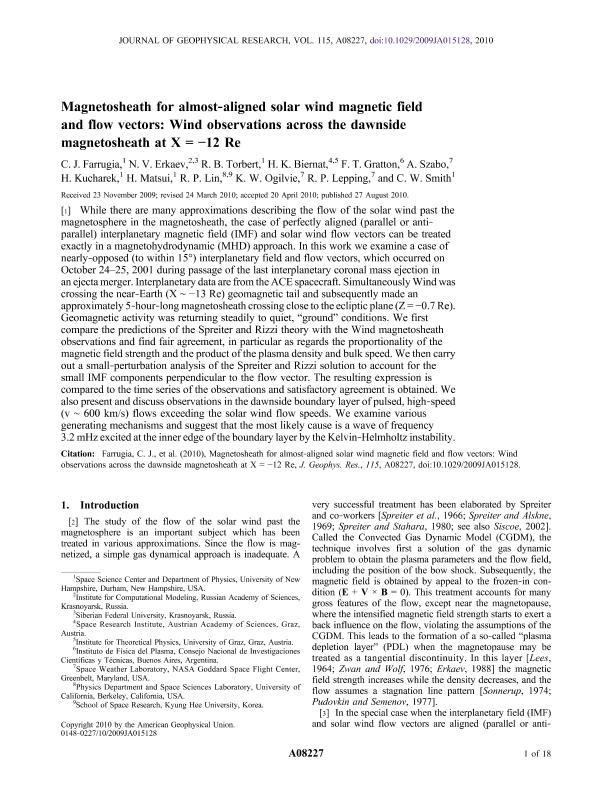Artículo
Magnetosheath for almost-aligned solar wind magnetic field and flow vectors: Wind observations across the dawnside magnetosheath at x = -12 Re
Farrugia, C. J.; Erkaev, N. V.; Torbert, R.; Biernat, H. K.; Gratton, Fausto Tulio Livio ; Szabo, A.; Kucharek, H.; Matsui, H.; Lin, R. P.; Ogilvie, K.; Lepping, R. P.; Smith, C. W.
; Szabo, A.; Kucharek, H.; Matsui, H.; Lin, R. P.; Ogilvie, K.; Lepping, R. P.; Smith, C. W.
 ; Szabo, A.; Kucharek, H.; Matsui, H.; Lin, R. P.; Ogilvie, K.; Lepping, R. P.; Smith, C. W.
; Szabo, A.; Kucharek, H.; Matsui, H.; Lin, R. P.; Ogilvie, K.; Lepping, R. P.; Smith, C. W.
Fecha de publicación:
08/2010
Editorial:
Blackwell Publishing Ltd
Revista:
Journal of Geophysical Research: Space Physics
ISSN:
2169-9402
Idioma:
Inglés
Tipo de recurso:
Artículo publicado
Clasificación temática:
Resumen
While there are many approximations describing the flow of the solar wind past the magnetosphere in the magnetosheath, the case of perfectly aligned (parallel or anti-parallel) interplanetary magnetic field (IMF) and solar wind flow vectors can be treated exactly in a magnetohydrodynamic (MHD) approach. In this work we examine a case of nearly-opposed (to within 15) interplanetary field and flow vectors, which occurred on October 24-25, 2001 during passage of the last interplanetary coronal mass ejection in an ejecta merger. Interplanetary data are from the ACE spacecraft. Simultaneously Wind was crossing the near-Earth (X ∼ -13 Re) geomagnetic tail and subsequently made an approximately 5-hour-long magnetosheath crossing close to the ecliptic plane (Z = -0.7 Re). Geomagnetic activity was returning steadily to quiet, "ground" conditions. We first compare the predictions of the Spreiter and Rizzi theory with the Wind magnetosheath observations and find fair agreement, in particular as regards the proportionality of the magnetic field strength and the product of the plasma density and bulk speed. We then carry out a small-perturbation analysis of the Spreiter and Rizzi solution to account for the small IMF components perpendicular to the flow vector. The resulting expression is compared to the time series of the observations and satisfactory agreement is obtained. We also present and discuss observations in the dawnside boundary layer of pulsed, high-speed (v ∼ 600 km/s) flows exceeding the solar wind flow speeds. We examine various generating mechanisms and suggest that the most likely cause is a wave of frequency 3.2 mHz excited at the inner edge of the boundary layer by the Kelvin-Helmholtz instability. Copyright 2010 by the American Geophysical Union.
Palabras clave:
Magnetosphere
,
Kelvin-Helmholtz
,
Waves
,
Instabilities
Archivos asociados
Licencia
Identificadores
Colecciones
Articulos(INFINA)
Articulos de INST.DE FISICA DEL PLASMA
Articulos de INST.DE FISICA DEL PLASMA
Citación
Farrugia, C. J.; Erkaev, N. V.; Torbert, R.; Biernat, H. K.; Gratton, Fausto Tulio Livio; et al.; Magnetosheath for almost-aligned solar wind magnetic field and flow vectors: Wind observations across the dawnside magnetosheath at x = -12 Re; Blackwell Publishing Ltd; Journal of Geophysical Research: Space Physics; 115; 8; 8-2010; 1-18
Compartir
Altmétricas



